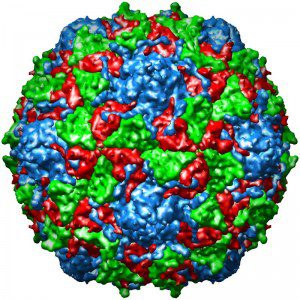

Members of the family Picornaviridae, which include Hepatitis A virus, poliovirus, and Coxsackieviruses, have non-enveloped particles that consist of a protein shell surrounding the viral RNA genome (poliovirus is illustrated). Examples of viruses that are enveloped include dengue virus, influenza virus, and measles virus.
Recently it was discovered that hepatitis A virus (HAV) particles are released from cells in membrane vesicles containing 1-4 virus particles. These membranous structures resemble exosomes, which are also released from uninfected cells and play roles in various biological processes. Enveloped hepatitis A virus particles are present in the blood of infected humans. However virus in the feces, which is transmitted to other hosts, is not enveloped.
Viral envelopes typically contain viral glycoproteins, such as the HA protein of influenza viruses, which serve important functions during replication, such as attachment to cell receptors. Envelope glycoproteins are also the target of antibodies that block viral infection. The presence of an envelope makes HAV resistant to neutralization with antibodies, because the membrane contains no viral proteins that can be blocked by antibodies.
Two other non-enveloped picornaviruses, Coxsackievirus B and poliovirus, are also released from cells within membrane vesicles. These virus particles are in vesicles derived from the autophagy pathway, which captures and recycles cytoplasmic contents by ejecting them from the cell.
What is the function of the membrane acquired by these naked viruses? Perhaps immune evasion: the presence of the cell membrane makes HAV and Coxsackievirus B virus particles resistant to neutralization with antibody. The ability to deliver multiple virus particles to a single cell might help to overcome genetic defects in the viral genome that are a consequence of the high mutation rates of these viruses.
An interesting problem is how these cloaked viruses enter cells, because there is no evidence that the membranes contain any viral proteins that could interact with a cell receptor. Nevertheless, entry of enveloped HAV and poliovirus into cells requires the known viral receptor. Perhaps the vesicles are taken into the cell by endocytosis, where viral particles are released from the vesicles, and then bind receptors to initiate escape of the genome.
Should HAV, poliovirus, and Coxsackievirus B be reclassified as enveloped viruses? Probably not, in part because the membranes surrounding these virus particles are not needed for infectivity. In contrast, removal of the membrane from influenza virus, dengue virus, or measles virus destroys their infectivity. Enveloped viruses acquire a membrane after the internal components have been assembled, whether they are helical or icosahedral nucleocapsids. In contrast, HAV, poliovirus, and Coxsackievirus B become fully infectious particles before they acquire an envelope.
Another argument against calling picornaviruses enveloped is that viral membranes contain viral glycoproteins that allow attachment to cell receptors and release of the viral genome into the cell. There is no evidence that the membranes of picornaviruses contain viral proteins.
The acquisition of a membrane may have taken place later in the evolution of picornaviruses, to allow more efficient infection or evasion of host responses. Alternatively, the membrane may simply be a by-product acquired when these viruses exit the cell by a non-lytic mechanism.
While the finding of membranes around picornavirus particles is intriguing, I am not yet convinced that these viruses should be considered to be enveloped. I would like to know if other non-enveloped viruses are similarly released from cells in membranous cloaks, and the function of this addition for viral replication in the host.

I think the idea that this is a strategy to cooperatively overcome potentially harmful mutations is very interesting. I wonder if it is the same for other mutagenic viruses?
Retroviruses package two copies of the RNA genome, and it is believed this is to overcome lethal mutations (the polymerase copies both strands). Whether other viruses achieve the same by putting an envelope around multiple particles remains to be seen.